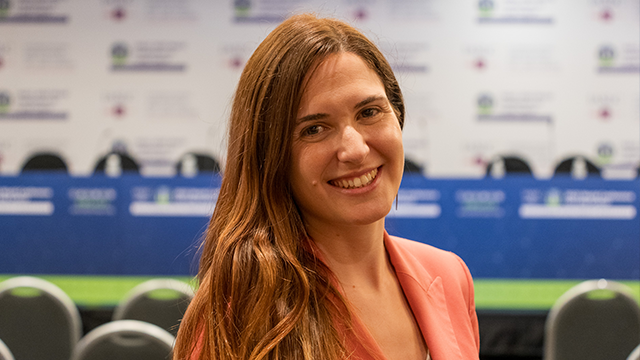Presented by Prof Em Johan Vansteenkiste (University Hospitals Leuven, Leuven, Belgium)
In this video, Prof Em Johan Vansteenkiste, thoracic oncologist at the University Hospitals Leuven, discusses the key take-aways from the first proferred paper session of the 2025 European Lung Cancer Conference (ELCC).
The most anticipated presentation at ELCC 2025 featured the overall survival (OS) data of the randomized-controlled, phase III MARIPOSA study.1 In this trial, 1017 patients with locally advanced or metastatic EGFR-mutant non-small-cell lung cancer (NSCLC) were randomly assigned (2:2:1) to receive osimertinib monotherapy, a combination of lazertinib and the EGCFR-MET directed bispecific antibody amivantamab, or lazertinib alone. Previously, this study showed that the lazertinib-amivantamab combination was associated with a significant 30% reduction in the risk of disease progression or death compared to osimertinib. The data presented at ELCC show that this delayed disease progression also translated into a significantly longer OS for patients in the lazertinib-amivantamab arm (HR[95%CI]: 0.75[0.61-0.92]; p< 0.005). After a median follow-up of 37.8 months, the median OS with lazertinib-amivantamab was not yet reached, while this was reported at 36.7 months for osimertinib. The OS curves continue to widen over time and the investigators project that the median OS in the experimental arm will eventually be more than a year longer than what is seen with osimertinib. Importantly, this OS benefit did come at the cost of important toxicity, with skin rash, venous thromboembolism and infusion-related reactions as the most prominent and bothersome adverse events (AEs). While strategies, such as specific dermatological care, prophylactic anticoagulation and premedication with corticosteroids, can mitigate these AEs to a certain extent, this increased toxicity will continue to be an important consideration in 1st line treatment decisions. In addition, the lazertinib-amivantamab treatment currently requires 2-weekly visits to the hospital to receive the intravenous therapy, whereas osimertinib is orally available, meaning that patients only have to come to the hospital every three months. For Prof Vansteenkiste, these differences in treatment and toxicity burden will likely mean that lazertinib-amivantamab will be reserved for patients with poor prognostic factors (e.g., comutations, mixed EGFR, ctDNA positive), while the more ‘straightforward cases’ will still be managed with osimertinib.
Two other interesting studies presented during the first proferred paper session looked at the management of EGFR-mutant patients who progressed on first line osimertinib. In the SAVANNAH trial, the combination of osimertinib with the MET inhibitor savolitinib resulted in an objective response rate (ORR) of 55% and a median PFS of 7.5 months in a cohort of EGFR-mutant mNSCLC patients with MET dysregulation who progressed on first line osimertinib. While this is better than what is achieved with the current standard of care (platinum-pemetrexed chemotherapy), this treatment did come with a considerable toxicity burden, with grade ≥3 AEs in 36% of patients and 16% of patients discontinuing their therapy due to AEs.2 A phase III study (SAFFRON) comparing this combination to platinum-pemetrexed in EGFR-mutant NSCLC patients with MET overexpression/amplification post-osimertinib is currently ongoing.
In the phase II ORCHARD study, EGFR-mutant mNSCLC patients who progressed on osimertinib were treated with a combination of osimertinib and the antibody-drug-conjugate (ADC) Dato-DXd. This combination proved to be active, with an ORR of about 55% and a median PFS of 9.5 months with the 4 mg/kg dose of Dato-DXd and 11.7 months when this drug was used at a dose of 6 mg/kg. As could be expected, this higher dose of Dat-DXd did bring about a higher rate of toxicity, with 55% of patients experiencing grade ≥3 AEs, the most worrisome being stomatitis (10% grade ≥3) and interstitial lung disease (6% grade ≥3). Given this high toxicity burden, questions can be raised whether it would not be better to use Dat-DXd as monotherapy in this setting.3
A final abstract that was selected by Prof Vansteenkiste consists of an update of the phase II SOHO-1 trial evaluating BAY 2927088, a TKI targeting HER2 and EGFR, in patients with HER2– or EGFR-mutant mNSCLC. During ELCC 2025, results of cohorts D and E in this trial were presented, respectively evaluating this agent in HER2-positive patients naïve to HER2-targted therapies and in patients who previously received a HER2-targeted ADC. In Cohort D (ADC-naïve), an ORR of 70.5% was obtained, while the ORR was 35.3% in patients who previously received T-DXd. With respect to safety BAY 2927088 came with a substantial 25% grade ≥3 rate of diarrhea. In the phase III SOHO-2 trial, BAY 2927088 is currently being compared to chemotherapy +/- immunotherapy in the first line treatment of patients with HER2-positive mEGFR.4
References:
- Yang J et al. ELCC 2025. Abstract 4O.
- Ahn M-J et al. ELCC 2025. Abstract 2O.
- Le X et al. ELCC 2025. Abstract 1O.
- Girard N, et al. ELCC 2025. Abstract 3O.



